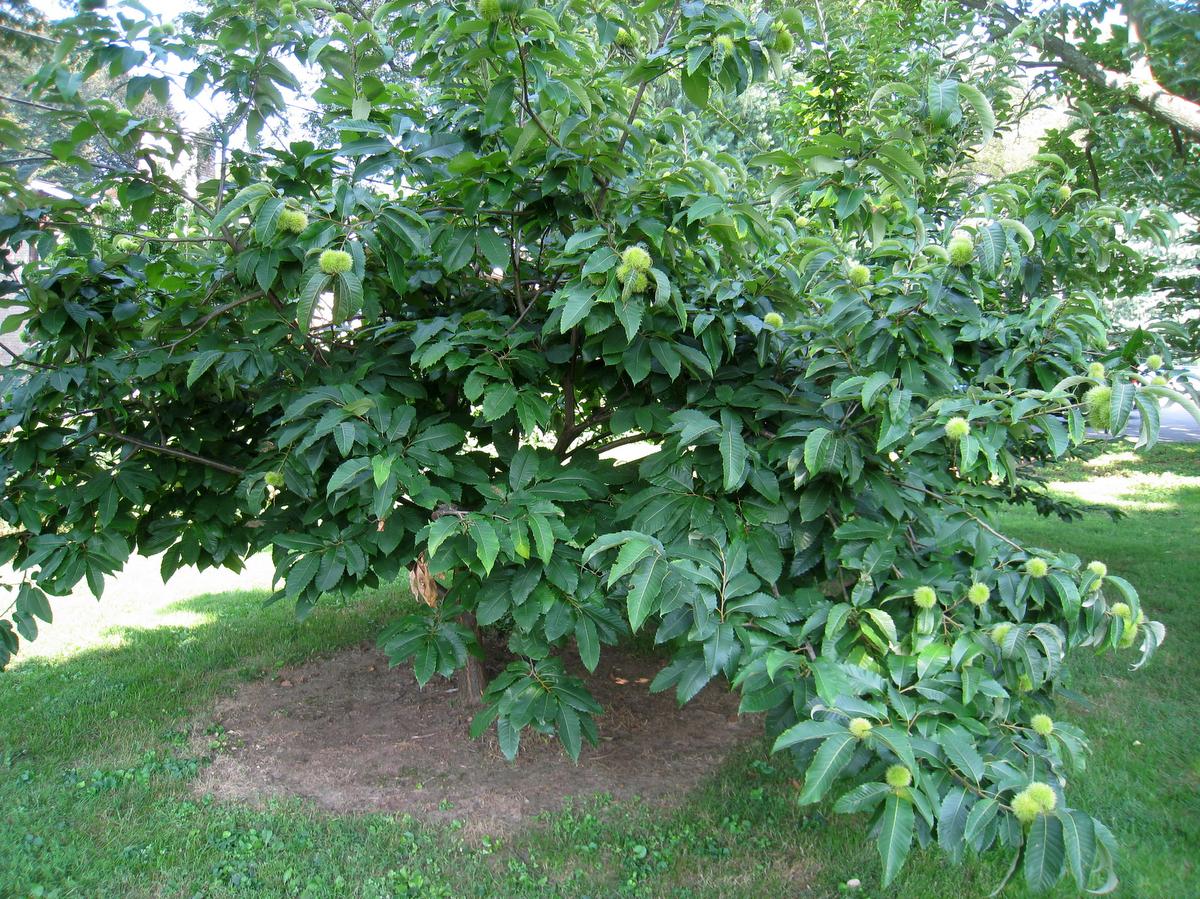The scientist Jared Diamond has suggested that Europeans were able to conquer peoples on other continents (instead of vice-versa) at least in part because they kept livestock. Having lived side-by-side with their animals for centuries, Europeans had developed partial immunity to zoonoses such as smallpox; native Americans had no immunity and were decimated by the new diseases.
The story of the native American tribes is strikingly similar to that of the American chestnut (Castanea dentata). The chestnut was a common species in the deciduous forests of the upland Appalachian region, which stretches from Maine to northern Mississippi and includes southern New York. In the late nineteenth century, the chestnut blight fungus was accidentally introduced to New York City in a shipment of Japanese chestnut trees. The East Asian chestnut species evolved alongside the fungus and are mostly unaffected by it, but the American chestnut had no resistance to the unfamiliar pathogen. The fungus infiltrated cracks in the bark, carving deep cankers that quickly killed their hosts. The spores traveled at a heartbreaking pace, carried on air currents as well as on the feet and feathers of animals and the equipment of loggers, who cut down the surviving chestnuts – ironically, the very trees that might have had some natural resistance to the disease. By the mid-twentieth century, the American chestnut had disappeared from all but a few isolated areas.

Photo: American Chestnut in the Louise Arnold Tanger Arboretum, Lancaster, PA, 2009. Photo: Daderot/CC-BY
The so-called “redwood of the East” was a keystone species and its loss changed the forests irreparably. The tree grew rapidly to a giant size – 100 feet high, four to five feet in diameter – and its spreading branches threw the forest floor below into deep shade. Moth caterpillars ate the leaves; the sturdy branches supported massive flocks of passenger pigeons; the large, abundant, starchy nuts fed bear, white-tailed deer, and wild turkey. Even in death, the tree shaped its environment. The fast-decaying leaves leached their nutrients into the soil and streams, while the rot-resistant branches fell into water and created hiding places for fish. It was a source of food and medicine for both Native Americans and Europeans, and the latter also fed its nuts and sprouts to their livestock. The bark was used for tanning leather; the straight, strong wood made everything from musical instruments to log cabins to railroad ties and caskets.
As the blight strangled chestnuts into skeletons, gaps opened up in the forest canopy and sun-loving plants flourished. The vacant real estate filled in gradually with birch, oak, tulip, hickory, and maple. But now there was less food for animals and humans alike. Acorns are smaller than chestnuts and their numbers fluctuate wildly from year to year; hickories and beeches are even more unreliable as mast producers. The passenger pigeon population was already in steep decline, but the species might have survived if it had not relied so heavily on chestnuts for food and places to roost.
The passenger pigeon is now extinct, as is the subsistence culture of the Appalachians, but the chestnut is still alive, barely. Since the disease does not attack the root system, old chestnut stumps – and there may be sixty million left in New York State — still doggedly send up sprouts, though these are quickly killed by the fungus, which lurks in other forest trees. Researchers, heartened by its persistence, have been working to bring it back from the dead for years. They have genetically altered the fungus to be less virulent, introduced a fungus-destroying virus into infected trees, and irradiated seeds in hopes of developing a blight-resistant mutant. One program interbreeds naturally resistant native chestnuts with each other; another has bred trees that are 1/16 Chinese, 15/16 American. Many of these methods work to some extent, but only William Powell’s team at SUNY-ESF seems to have found a reliable solution: by transferring a critical gene from wheat to the chestnut, they have created transgenic trees that are blight-tolerant and, unlike the Chinese hybrids, adapted to their local environments. If the chestnut is re-introduced, it might even help to address another man-made environmental problem: climate change. Chestnuts grow remarkably fast, sequestering much more carbon than other species, and their hard, durable wood would be used in long-lasting products like furniture. Whether or not the resurrected chestnut can adapt to a rapidly changing climate, however, remains to be seen. The transgenic chestnut will hopefully be submitted to the USDA for full review in December 2018 and may be in a forest near you as early as mid-2020.

